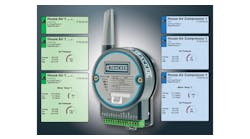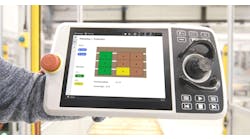Regardless of the type or scale of your manufacturing operation, it’s getting more difficult to compete without some kind of Industrial Internet of Things implementation. Applying IIoT capabilities in pneumatic processes can save your business time and money, just as it does for other production processes and industrial equipment.
Incorporating IIoT technology into pneumatic systems at the device level is an overdue opportunity and a welcome challenge. Here’s what’s worth knowing about trends in IIoT for pneumatic components and system design.
The IIoT is less a cloud and more a central nervous system. It gathers data from throughout an operation and turns it into action.
Here are some advantages of IIoT for pneumatic system design, as well as ideas for making the most of them.
Deploy on-device analytics — Advances in programmable logic controllers (PLCs) have made it easier than ever to embed machine intelligence at the device level. We know this where to find of some of the most valuable data when it comes to equipment and industrial processes. However, performing analysis of that information on-device is a superior approach – more efficient, more responsive — compared to offloading it to a second location.
Some pneumatic valve manifolds on the market today provide a variety of local IIoT analytics tools that reveal actionable data in real-time without high infrastructure costs and bandwidth worries.
Unlock legacy machine value with retrofits — Device-level analytics fulfill the very purpose of the IIoT, which is to identify previously invisible problems. Sometimes this can involve legacy equipment that no longer provides the reliability or repeatability it once did. Intelligent pneumatic systems powered by the IIoT can breathe new life into this machinery.
For example, one grain packaging plant wanted to find out why its pneumatic gates were producing up to a 5-pound variance in its 75-pound bags of seed. It solved the problem by replacing its open-loop material-handling control system with a more intelligent, IIoT-based one.
Using pressure sensors to dynamically adjust the pneumatic gates helped the plant eliminate hours of rework per day, improve accuracy and post a 15% improvement in bags-per-hour processed. The closed-loop system allowed the seeds to flow freely without clumping up along the way and overfilling the product bags. It was possible thanks to an IIoT retrofit, rather than a replacement of an entire line of production equipment.
Know what you’re measuring and optimizing — Putting the IIoT into action in pneumatic systems means knowing what’s available for measuring and what your operation or client needs from the final design.
Here are some of the areas worth focusing on when it comes to applying the IIoT in pneumatic systems:
1. Performance and pressure. Monitoring the performance of valve cylinders with smart manifolds measures how long it takes for them to complete one full cycle. Users define their desired performance, and the system automatically sends an alert when it falls out of expectations and threatens productivity.
Knowing when filtration elements require replacement is another ideal application for the IIoT. Problems with filter pressure and performance threaten the whole system’s productivity. Again, local analysis of variations in the data alert operators to replace or attend to filters.
Other variables of note for a pneumatic design specialist, which the IIoT exists to bring to the surface, include temperature, flow rate, valve response times, and cycle time and pressure.
2. Energy efficiency. The search for greater energy efficiency is one of the primary reasons the IIoT is coming into more widespread use. IIoT edge gateways for compressed air systems in manufacturing settings provide highly detailed information that informs users of the presence, location, and severity of leaks.
As these systems have to work against losses in pressure, more energy is expended needlessly. Here, the IIoT provides a relatively simple tool to realize several goals at once.
With this in mind, AVENTICS has put forward its Smart Pneumatics Analyzer, a portable device that integrates pneumatic systems with the IIoT. This device works by plugging into wherever businesses store equipment and IIoT sensors, instantly allowing an operator to collect data and make adjustments before moving on to the next piece of hardware.
Unlike an office computer, the user can view the data and work on equipment at the same time, even if the local system component or controller doesn’t have a display screen of its own.
3. Safety and maintenance. The consequences of pneumatic system failure are sometimes more catastrophic than downturns in productivity. Another way the IIoT puts local intelligence to work in pneumatics involves progressive cushioning.
One of the more dramatic examples is the hydraulic cylinders that cushion flood gates on their way down. These can be massive structures, and a failure of the limit switches could mean catastrophic damage and lives lost. Progressive cushioning applies to large-scale pneumatic structures as well as small-scale hydraulic ones.
In the case of heavy gates, smart safety technologies add another, much more robust, layer to existing failsafes. By calculating the load of the gate or other structure in real-time, IIoT devices for progressive cushioning mean safety stops and air cushions don’t receive any surprises as external conditions change.
For air-powered manufacturing and material handling equipment, consider the consequences of a change in valve response time as a machine gets older.
With the IIoT in place, the manufacturer could receive a much more timely indication of impending failure for critical equipment. Instead of performing reactionary maintenance and potentially forcing operators to run machinery into the unsafe portion of its lifecycle, upkeep and even replacements become proactive instead.
Addressing concerns and cultivating buy-in — The IIoT has the potential to take part in every operation in the plant, so some employees and operators may be concerned when you originally put forth the idea.
One of the initial concerns is the possible invasion of user privacy and company IP. With the IIoT “watching” everything, some workers may worry it’s watching them, too. Jeff Rizzie, senior manager of business development at Sandvik Coromant, says it’s likely some operators will push back against the idea:
"[O]perators saying their bosses will know every time they open the door or the machine’s not running, and they get a little nervous about that. We’re not bringing this technology in ... to keep an eye on you but to help you run the operation better.”
Another, far more worrying problem is the opportunities the IIoT poses for hackers. With everything connected, the plant may be at greater risk for data theft. An attack instantly taking out all of the equipment and shutting down operations is possible, as we’ve seen with a recent uptick in attacks on industrial control systems.
Hackers sometimes take a passive approach and invade systems to see how the operators run it, stealing data and company secrets for their own use without anyone noticing, potentially for months or years. IT departments and cybersecurity should be realistic about the risks, and they should be involved in the selection of the IIoT vendor, especially where company security credentials are concerned.
As described here, the underlying pneumatic systems do not have to be replaced for an operator to implement IIoT applications. The work of exploring new ways to put the IIoT to work is an unfolding challenged, and a rewarding one. More fully automated systems and efficient processes will save valuable time and money, beginning with some of the most important equipment on the production line.
Megan Nichols is a STEM writer and blogger who writes on a wide range of scientific topics at schooledbyscience.com. Her recent work has included Quick Tips for Machining Hard Materials and 9 Popular Choices for EMI Shielding. Follow Megan on Twitter @nicholsrmegan.






